Clinical Decision Support Systems: Healthcare Advancement Report
VerifiedAdded on 2020/04/13
|5
|1231
|297
Report
AI Summary
This report examines Clinical Decision Support Systems (CDSS) as a key technology in modern healthcare, focusing on their role in improving patient care and streamlining clinical decision-making. The paper details the benefits of CDSS, including enhanced patient safety, improved medication practices, and increased healthcare quality through reduced errors, cost savings, and more efficient processes. It also addresses the challenges, such as the potential for 'deskilling' healthcare professionals, the limitations of current technology, and ethical considerations. The report traces the evolution of CDSS, from early knowledge-based systems to more advanced AI and machine learning models. It concludes by hypothesizing future advancements, particularly through integrating quantum computing and artificial neural networks, to further enhance diagnostic capabilities and improve healthcare outcomes. The report references several sources to support the analysis.
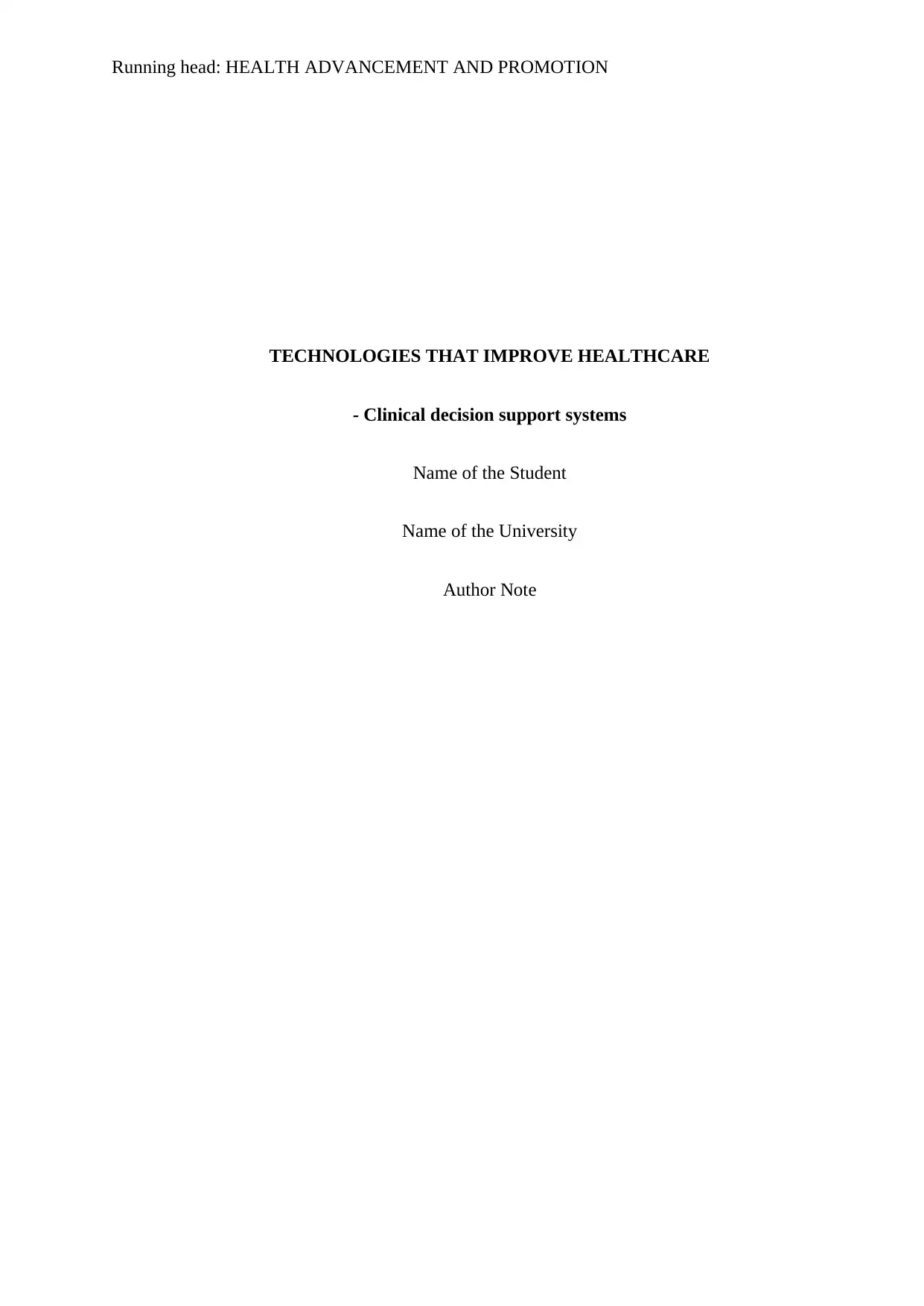
Running head: HEALTH ADVANCEMENT AND PROMOTION
TECHNOLOGIES THAT IMPROVE HEALTHCARE
- Clinical decision support systems
Name of the Student
Name of the University
Author Note
TECHNOLOGIES THAT IMPROVE HEALTHCARE
- Clinical decision support systems
Name of the Student
Name of the University
Author Note
Paraphrase This Document
Need a fresh take? Get an instant paraphrase of this document with our AI Paraphraser
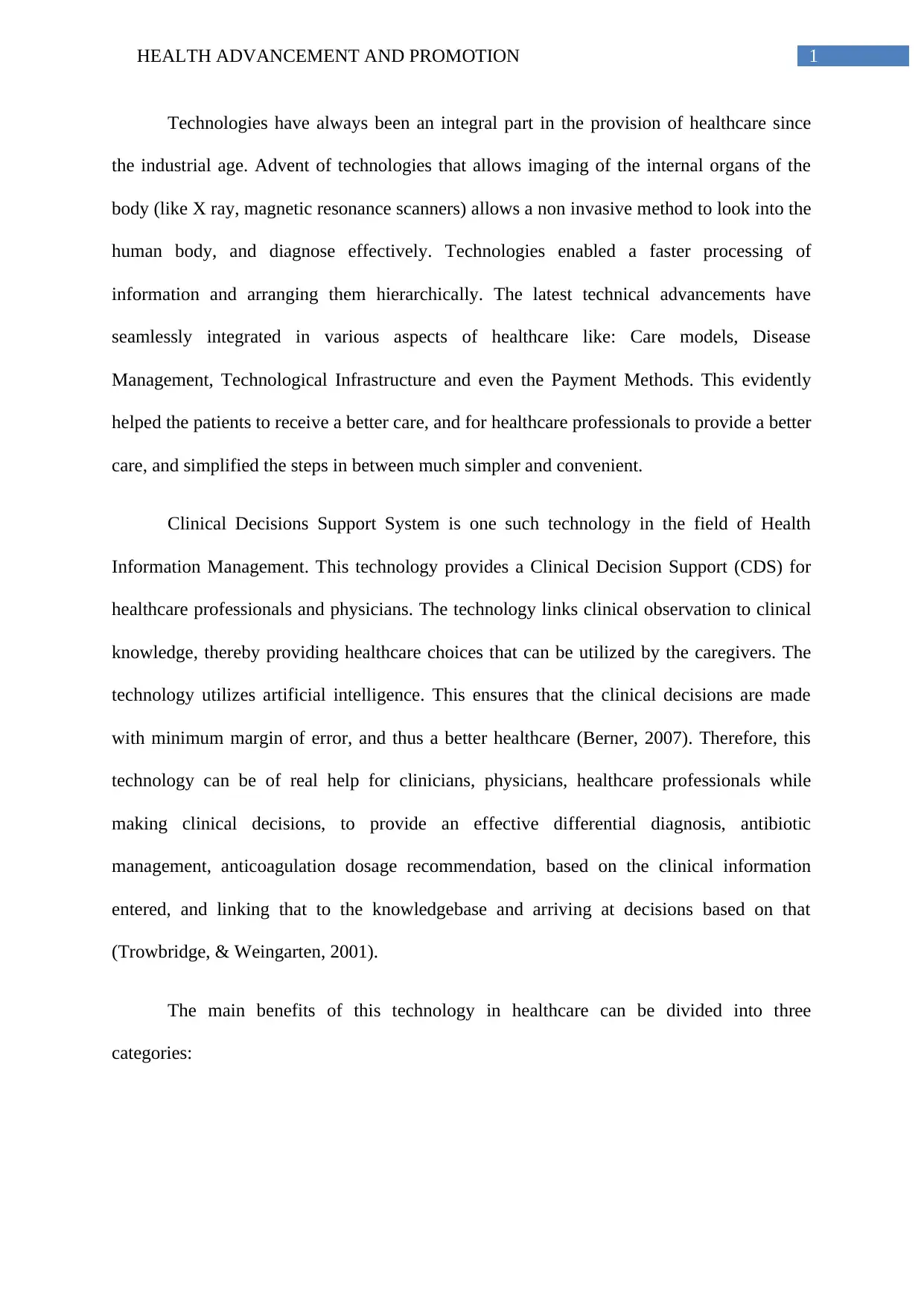
1HEALTH ADVANCEMENT AND PROMOTION
Technologies have always been an integral part in the provision of healthcare since
the industrial age. Advent of technologies that allows imaging of the internal organs of the
body (like X ray, magnetic resonance scanners) allows a non invasive method to look into the
human body, and diagnose effectively. Technologies enabled a faster processing of
information and arranging them hierarchically. The latest technical advancements have
seamlessly integrated in various aspects of healthcare like: Care models, Disease
Management, Technological Infrastructure and even the Payment Methods. This evidently
helped the patients to receive a better care, and for healthcare professionals to provide a better
care, and simplified the steps in between much simpler and convenient.
Clinical Decisions Support System is one such technology in the field of Health
Information Management. This technology provides a Clinical Decision Support (CDS) for
healthcare professionals and physicians. The technology links clinical observation to clinical
knowledge, thereby providing healthcare choices that can be utilized by the caregivers. The
technology utilizes artificial intelligence. This ensures that the clinical decisions are made
with minimum margin of error, and thus a better healthcare (Berner, 2007). Therefore, this
technology can be of real help for clinicians, physicians, healthcare professionals while
making clinical decisions, to provide an effective differential diagnosis, antibiotic
management, anticoagulation dosage recommendation, based on the clinical information
entered, and linking that to the knowledgebase and arriving at decisions based on that
(Trowbridge, & Weingarten, 2001).
The main benefits of this technology in healthcare can be divided into three
categories:
Technologies have always been an integral part in the provision of healthcare since
the industrial age. Advent of technologies that allows imaging of the internal organs of the
body (like X ray, magnetic resonance scanners) allows a non invasive method to look into the
human body, and diagnose effectively. Technologies enabled a faster processing of
information and arranging them hierarchically. The latest technical advancements have
seamlessly integrated in various aspects of healthcare like: Care models, Disease
Management, Technological Infrastructure and even the Payment Methods. This evidently
helped the patients to receive a better care, and for healthcare professionals to provide a better
care, and simplified the steps in between much simpler and convenient.
Clinical Decisions Support System is one such technology in the field of Health
Information Management. This technology provides a Clinical Decision Support (CDS) for
healthcare professionals and physicians. The technology links clinical observation to clinical
knowledge, thereby providing healthcare choices that can be utilized by the caregivers. The
technology utilizes artificial intelligence. This ensures that the clinical decisions are made
with minimum margin of error, and thus a better healthcare (Berner, 2007). Therefore, this
technology can be of real help for clinicians, physicians, healthcare professionals while
making clinical decisions, to provide an effective differential diagnosis, antibiotic
management, anticoagulation dosage recommendation, based on the clinical information
entered, and linking that to the knowledgebase and arriving at decisions based on that
(Trowbridge, & Weingarten, 2001).
The main benefits of this technology in healthcare can be divided into three
categories:
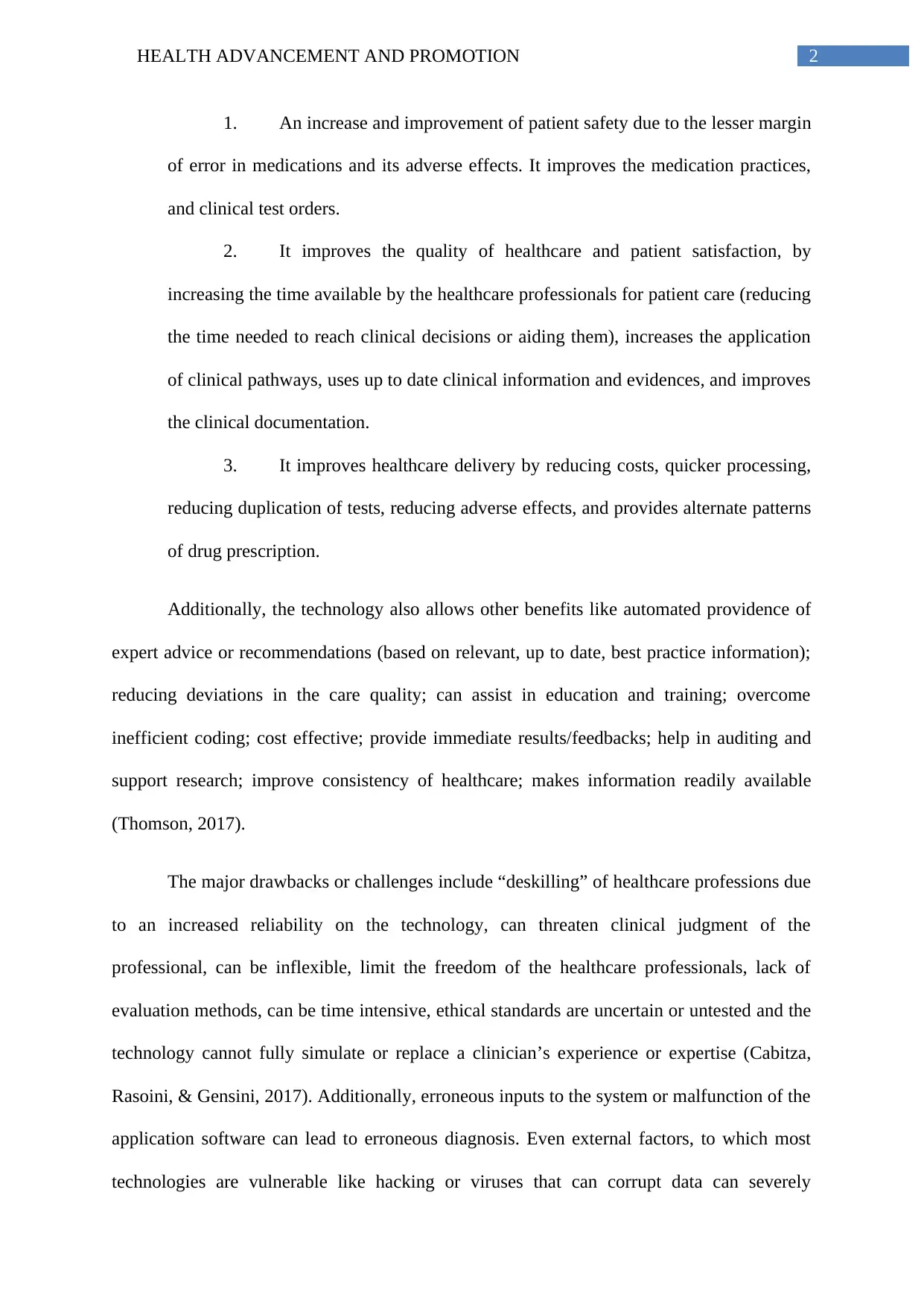
2HEALTH ADVANCEMENT AND PROMOTION
1. An increase and improvement of patient safety due to the lesser margin
of error in medications and its adverse effects. It improves the medication practices,
and clinical test orders.
2. It improves the quality of healthcare and patient satisfaction, by
increasing the time available by the healthcare professionals for patient care (reducing
the time needed to reach clinical decisions or aiding them), increases the application
of clinical pathways, uses up to date clinical information and evidences, and improves
the clinical documentation.
3. It improves healthcare delivery by reducing costs, quicker processing,
reducing duplication of tests, reducing adverse effects, and provides alternate patterns
of drug prescription.
Additionally, the technology also allows other benefits like automated providence of
expert advice or recommendations (based on relevant, up to date, best practice information);
reducing deviations in the care quality; can assist in education and training; overcome
inefficient coding; cost effective; provide immediate results/feedbacks; help in auditing and
support research; improve consistency of healthcare; makes information readily available
(Thomson, 2017).
The major drawbacks or challenges include “deskilling” of healthcare professions due
to an increased reliability on the technology, can threaten clinical judgment of the
professional, can be inflexible, limit the freedom of the healthcare professionals, lack of
evaluation methods, can be time intensive, ethical standards are uncertain or untested and the
technology cannot fully simulate or replace a clinician’s experience or expertise (Cabitza,
Rasoini, & Gensini, 2017). Additionally, erroneous inputs to the system or malfunction of the
application software can lead to erroneous diagnosis. Even external factors, to which most
technologies are vulnerable like hacking or viruses that can corrupt data can severely
1. An increase and improvement of patient safety due to the lesser margin
of error in medications and its adverse effects. It improves the medication practices,
and clinical test orders.
2. It improves the quality of healthcare and patient satisfaction, by
increasing the time available by the healthcare professionals for patient care (reducing
the time needed to reach clinical decisions or aiding them), increases the application
of clinical pathways, uses up to date clinical information and evidences, and improves
the clinical documentation.
3. It improves healthcare delivery by reducing costs, quicker processing,
reducing duplication of tests, reducing adverse effects, and provides alternate patterns
of drug prescription.
Additionally, the technology also allows other benefits like automated providence of
expert advice or recommendations (based on relevant, up to date, best practice information);
reducing deviations in the care quality; can assist in education and training; overcome
inefficient coding; cost effective; provide immediate results/feedbacks; help in auditing and
support research; improve consistency of healthcare; makes information readily available
(Thomson, 2017).
The major drawbacks or challenges include “deskilling” of healthcare professions due
to an increased reliability on the technology, can threaten clinical judgment of the
professional, can be inflexible, limit the freedom of the healthcare professionals, lack of
evaluation methods, can be time intensive, ethical standards are uncertain or untested and the
technology cannot fully simulate or replace a clinician’s experience or expertise (Cabitza,
Rasoini, & Gensini, 2017). Additionally, erroneous inputs to the system or malfunction of the
application software can lead to erroneous diagnosis. Even external factors, to which most
technologies are vulnerable like hacking or viruses that can corrupt data can severely
⊘ This is a preview!⊘
Do you want full access?
Subscribe today to unlock all pages.

Trusted by 1+ million students worldwide
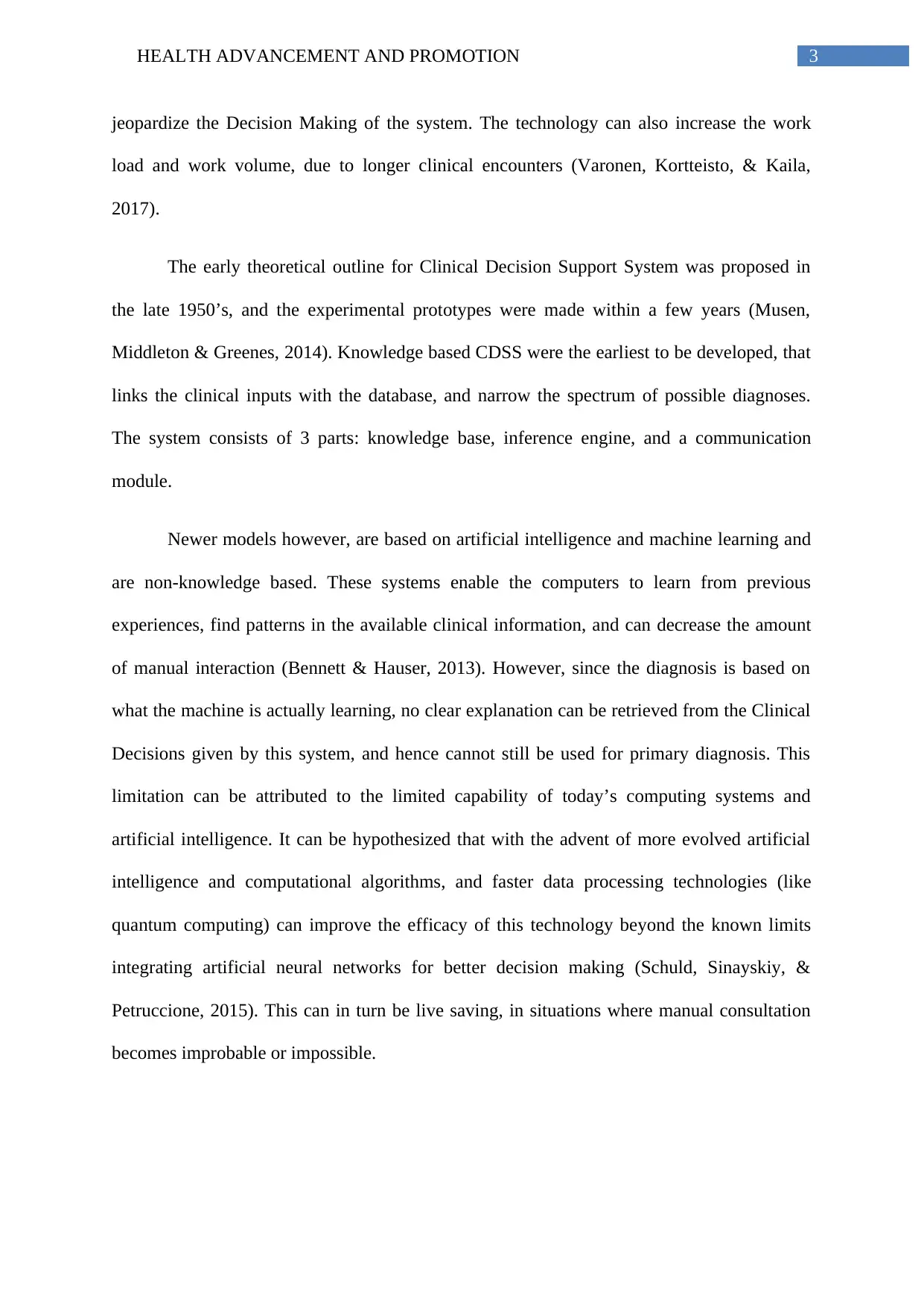
3HEALTH ADVANCEMENT AND PROMOTION
jeopardize the Decision Making of the system. The technology can also increase the work
load and work volume, due to longer clinical encounters (Varonen, Kortteisto, & Kaila,
2017).
The early theoretical outline for Clinical Decision Support System was proposed in
the late 1950’s, and the experimental prototypes were made within a few years (Musen,
Middleton & Greenes, 2014). Knowledge based CDSS were the earliest to be developed, that
links the clinical inputs with the database, and narrow the spectrum of possible diagnoses.
The system consists of 3 parts: knowledge base, inference engine, and a communication
module.
Newer models however, are based on artificial intelligence and machine learning and
are non-knowledge based. These systems enable the computers to learn from previous
experiences, find patterns in the available clinical information, and can decrease the amount
of manual interaction (Bennett & Hauser, 2013). However, since the diagnosis is based on
what the machine is actually learning, no clear explanation can be retrieved from the Clinical
Decisions given by this system, and hence cannot still be used for primary diagnosis. This
limitation can be attributed to the limited capability of today’s computing systems and
artificial intelligence. It can be hypothesized that with the advent of more evolved artificial
intelligence and computational algorithms, and faster data processing technologies (like
quantum computing) can improve the efficacy of this technology beyond the known limits
integrating artificial neural networks for better decision making (Schuld, Sinayskiy, &
Petruccione, 2015). This can in turn be live saving, in situations where manual consultation
becomes improbable or impossible.
jeopardize the Decision Making of the system. The technology can also increase the work
load and work volume, due to longer clinical encounters (Varonen, Kortteisto, & Kaila,
2017).
The early theoretical outline for Clinical Decision Support System was proposed in
the late 1950’s, and the experimental prototypes were made within a few years (Musen,
Middleton & Greenes, 2014). Knowledge based CDSS were the earliest to be developed, that
links the clinical inputs with the database, and narrow the spectrum of possible diagnoses.
The system consists of 3 parts: knowledge base, inference engine, and a communication
module.
Newer models however, are based on artificial intelligence and machine learning and
are non-knowledge based. These systems enable the computers to learn from previous
experiences, find patterns in the available clinical information, and can decrease the amount
of manual interaction (Bennett & Hauser, 2013). However, since the diagnosis is based on
what the machine is actually learning, no clear explanation can be retrieved from the Clinical
Decisions given by this system, and hence cannot still be used for primary diagnosis. This
limitation can be attributed to the limited capability of today’s computing systems and
artificial intelligence. It can be hypothesized that with the advent of more evolved artificial
intelligence and computational algorithms, and faster data processing technologies (like
quantum computing) can improve the efficacy of this technology beyond the known limits
integrating artificial neural networks for better decision making (Schuld, Sinayskiy, &
Petruccione, 2015). This can in turn be live saving, in situations where manual consultation
becomes improbable or impossible.
Paraphrase This Document
Need a fresh take? Get an instant paraphrase of this document with our AI Paraphraser
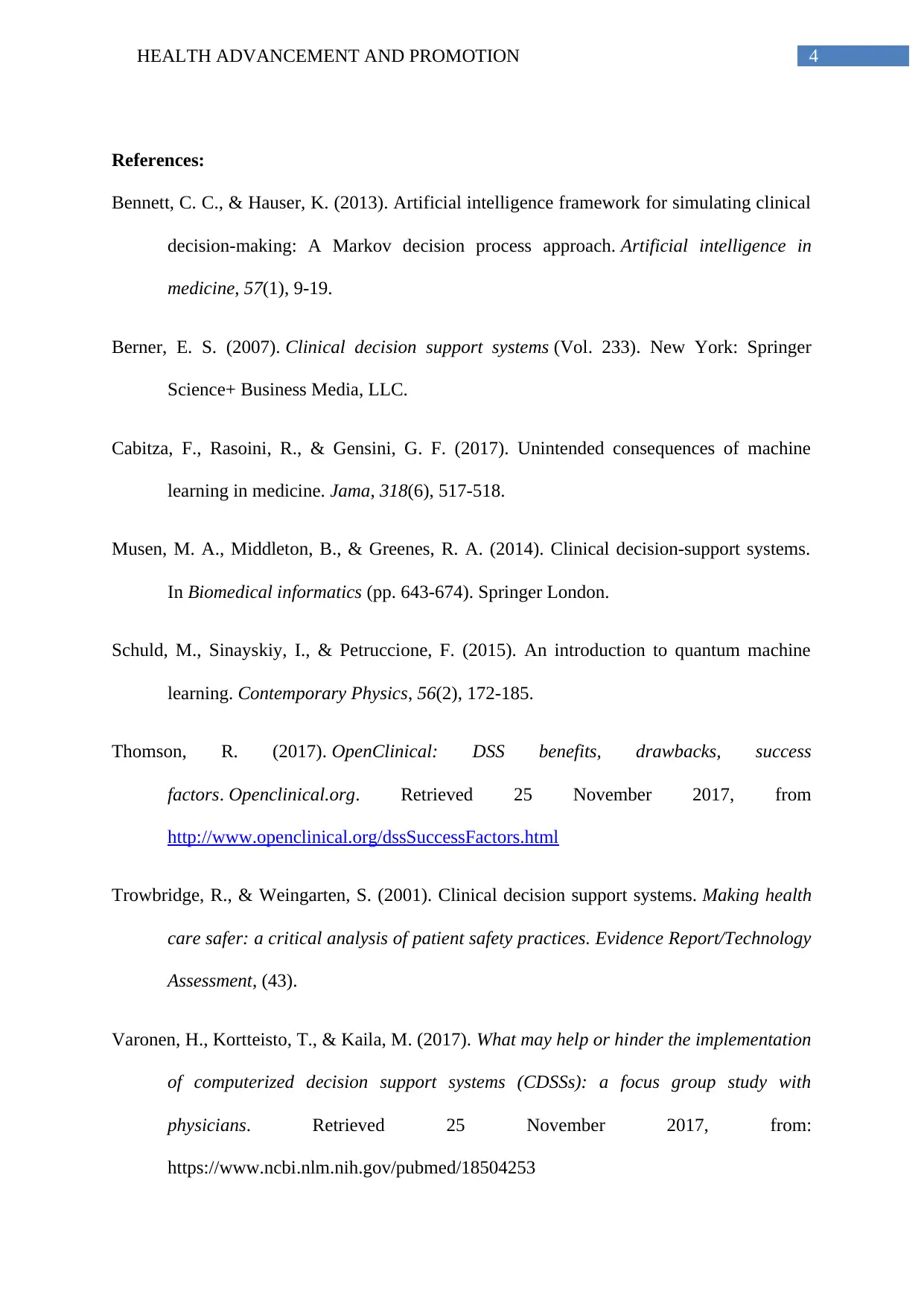
4HEALTH ADVANCEMENT AND PROMOTION
References:
Bennett, C. C., & Hauser, K. (2013). Artificial intelligence framework for simulating clinical
decision-making: A Markov decision process approach. Artificial intelligence in
medicine, 57(1), 9-19.
Berner, E. S. (2007). Clinical decision support systems (Vol. 233). New York: Springer
Science+ Business Media, LLC.
Cabitza, F., Rasoini, R., & Gensini, G. F. (2017). Unintended consequences of machine
learning in medicine. Jama, 318(6), 517-518.
Musen, M. A., Middleton, B., & Greenes, R. A. (2014). Clinical decision-support systems.
In Biomedical informatics (pp. 643-674). Springer London.
Schuld, M., Sinayskiy, I., & Petruccione, F. (2015). An introduction to quantum machine
learning. Contemporary Physics, 56(2), 172-185.
Thomson, R. (2017). OpenClinical: DSS benefits, drawbacks, success
factors. Openclinical.org. Retrieved 25 November 2017, from
http://www.openclinical.org/dssSuccessFactors.html
Trowbridge, R., & Weingarten, S. (2001). Clinical decision support systems. Making health
care safer: a critical analysis of patient safety practices. Evidence Report/Technology
Assessment, (43).
Varonen, H., Kortteisto, T., & Kaila, M. (2017). What may help or hinder the implementation
of computerized decision support systems (CDSSs): a focus group study with
physicians. Retrieved 25 November 2017, from:
https://www.ncbi.nlm.nih.gov/pubmed/18504253
References:
Bennett, C. C., & Hauser, K. (2013). Artificial intelligence framework for simulating clinical
decision-making: A Markov decision process approach. Artificial intelligence in
medicine, 57(1), 9-19.
Berner, E. S. (2007). Clinical decision support systems (Vol. 233). New York: Springer
Science+ Business Media, LLC.
Cabitza, F., Rasoini, R., & Gensini, G. F. (2017). Unintended consequences of machine
learning in medicine. Jama, 318(6), 517-518.
Musen, M. A., Middleton, B., & Greenes, R. A. (2014). Clinical decision-support systems.
In Biomedical informatics (pp. 643-674). Springer London.
Schuld, M., Sinayskiy, I., & Petruccione, F. (2015). An introduction to quantum machine
learning. Contemporary Physics, 56(2), 172-185.
Thomson, R. (2017). OpenClinical: DSS benefits, drawbacks, success
factors. Openclinical.org. Retrieved 25 November 2017, from
http://www.openclinical.org/dssSuccessFactors.html
Trowbridge, R., & Weingarten, S. (2001). Clinical decision support systems. Making health
care safer: a critical analysis of patient safety practices. Evidence Report/Technology
Assessment, (43).
Varonen, H., Kortteisto, T., & Kaila, M. (2017). What may help or hinder the implementation
of computerized decision support systems (CDSSs): a focus group study with
physicians. Retrieved 25 November 2017, from:
https://www.ncbi.nlm.nih.gov/pubmed/18504253
1 out of 5
Related Documents
Your All-in-One AI-Powered Toolkit for Academic Success.
+13062052269
info@desklib.com
Available 24*7 on WhatsApp / Email
![[object Object]](/_next/static/media/star-bottom.7253800d.svg)
Unlock your academic potential
Copyright © 2020–2025 A2Z Services. All Rights Reserved. Developed and managed by ZUCOL.





